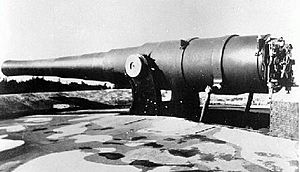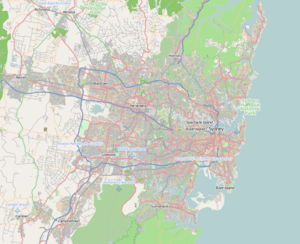Ben Buckler Gun Battery facts for kids
Quick facts for kids Ben Buckler Gun Battery |
|
|---|---|
| Ben Buckler, Sydney, New South Wales in Australia | |

Disappearing gun at Ben Buckler Gun Battery
|
|
|
Location in Greater Sydney
|
|
| Coordinates | 33°53′03″S 151°17′04″E / 33.884195°S 151.284410°E |
| Type | Disused gun battery |
| Site information | |
| Owner | Government of New South Wales |
| Controlled by |
|
| Open to the public |
Recreational uses as public open space |
| Site history | |
| Built | 1893 |
| In use | 1893 – 1950s |
| Materials | Concrete, brick, steel |
| Fate | Heritage site |
| Official name: Ben Buckler Gun Battery 1893, 9.2 Disappearing Gun; Bondi Battery' | |
| Type: | State heritage (archaeological-terrestrial) |
| Criteria: | a., b., c., e., f. |
| Designated: | 15 December 2006 |
| Reference #: | 1742 |
| Type: | Battery |
| Category: | Defence |
The Ben Buckler Gun Battery is a special old military site in Ben Buckler, Sydney, New South Wales, Australia. It was built in 1893 to help protect Sydney. This place used to have a powerful "disappearing gun."
Today, the site is a public park. It is also known as the Ben Buckler Gun Battery 1893, 9.2 Disappearing Gun, or Bondi Battery. The local council, Waverley Municipal Council, now owns it. It was added to the New South Wales State Heritage Register in 2006 because it's an important historical site.
Contents
History of Sydney's Coastal Defences
Early Fortifications
Sydney Harbour, also known as Port Jackson, needed protection from the very beginning. When the First Fleet arrived in 1788, they started building defenses. Early forts were at places like Dawes Point and Fort Phillip. These aimed to stop ships that had already entered the harbour.
Later, during the Napoleonic wars, Britain worried about its colonies being attacked. So, more defenses were built. A battery was set up at Georges Head around 1801. After American warships visited unexpectedly in 1839, new forts appeared at Kirribilli, Pinchgut, and Bradleys Head.
Changes in Defence Strategy
By 1870, British soldiers left Australia. This meant places like New South Wales and Victoria had to take care of their own defense. New forts were built at Middle Head, Georges Head, and South Head.
However, weapons kept getting better. This meant older forts quickly became outdated. By the 1880s, new types of forts were needed. Military experts suggested building strong outer defenses for Sydney's eastern suburbs in the 1890s.
The Role of Coastal Guns
Guns like the one at Ben Buckler were designed to use the latest technology. Their job was to scare away enemy ships approaching Sydney. These "counter-bombardment" guns had to be as powerful as the guns on warships. They worked with smaller guns and other defense systems like mines.
The main gun used was a 9.2-inch (23.4 cm) breech-loading gun. These were first made for the British Royal Navy. They were designed to match the powerful guns of other countries, like Germany.
The Ben Buckler Battery's Special Gun
The Disappearing Gun
In the late 1890s, three main guns protected Eastern Sydney. They were at Signal Hill Battery in Watsons Bay, Ben Buckler Battery in North Bondi, and Shark Point Battery in Clovelly. Each site had a single 9.2-inch British-made "disappearing gun."
These guns were popular around the world at the end of the 1800s. They were chosen for their long range and power. After firing, the gun would drop back into its hidden pit. This made it harder for enemy ships to hit. A strong metal shield covered the gun pit to protect it from incoming shells.
Gun Details and History
Ten of these large 9.2-inch disappearing guns were set up in Australia. Sydney had three, plus a spare. The gun at Ben Buckler was made in 1891 and installed in 1893. Its concrete walls were very thick, about 10 meters (33 feet)!
Moving the gun from Victoria Barracks, Sydney, was a huge task. It weighed about 22 tons (20,000 kg) and needed 36 horses. The journey took three weeks! This gun could fire a 172 kg (379 lb) shell up to 8,200 meters (5 miles).
In 1908, there was a report about the Ben Buckler gun firing by accident. This showed how dangerous this new technology could be. By the 1920s, newer, more modern guns were being used.
What Happened to the Gun?
The Ben Buckler gun site is still here today because of some interesting events. By World War II, the gun was old and not used much. After the war, the military got rid of most coastal guns. They tried to sell the Ben Buckler gun for scrap metal, but no one wanted it.
So, in the 1950s, the gun was buried. Waverley Council decided to cover it with about five feet of sand. The area then became part of a public park. The gun, its hydraulic system, and its concrete pit were all buried.
Rediscovery and Importance
Uncovered in 1984
People forgot about the gun until 1984. Workers were digging trenches for a sewerage project when they found it. Mechanical diggers uncovered the top of the concrete pit. Photos were taken, and the site was surveyed.
Because of this discovery, the site was included in a heritage study in 1990. Its likely location was added to a map of the Hugh Bamford Reserve. Experts believe the gun is still buried there, even though it hasn't been fully dug up again.
Current Condition and Value
The Ben Buckler gun battery site is a rare example of a strong concrete gun pit built mostly underground. When it was partly uncovered in 1984, it seemed to be in very good condition. It's thought that the entire concrete structure, the gun, and its hydraulic parts are still there.
Military experts think the Ben Buckler gun is perhaps the best example of its kind in Australia. It can teach us a lot about late 19th-century "disappearing gun" technology. It also shows how coastal defense plans changed as weapons and warfare improved. This site is special because it's one of only three such large guns built in New South Wales, and it's the only one that still has its main parts.
Heritage Listing
The Ben Buckler (Bondi) battery site is a unique and important historical place from the late Victorian period. It's special because:
- It's a rare, intact concrete gun pit from the 1890s, built for the new "disappearing guns."
- It likely still has its original 9.2-inch naval gun and its mounting. This would make it the only complete example of its kind in Australia.
- It was one of only three large coastal batteries in New South Wales. It shows how technology changed to deal with fast, powerful armored ships.
- The forts built in Sydney's eastern suburbs in the 1890s were the result of many years of planning. They show how defense policies changed to meet new threats and warfare styles.
The Ben Buckler Gun Battery was added to the New South Wales State Heritage Register on 15 December 2006. This means it's officially recognized as a very important part of New South Wales's history.


